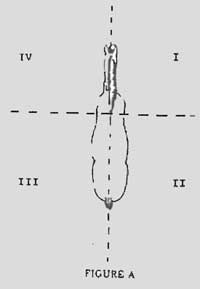Showmanship
Showmanship at Halter

Mark Arns, Ph.D., Mary Ann Papay-Harris, M.S., Libby Lugar, M.S., & Sue Webb, M.S.
Showmanship is designed to judge the exhibitor's ability to present the horse. The horse is a prop to allow the contestant to illustrate his/her abilities.
I) Appearance of horse:
a. Clipping
1. The horse should be clipped before each show. Special attention should be given to the muzzle, eyes, ears, bridle path, and under the jaw.
2. Horses with white markings on the legs should be clipped. This should be done several days before the show in order for hair to "blend in". Clip only thehair which is white. Be careful not to clip into the dark hair.
Figure 8. A properly clipped horse produces a finished look which will contribute to a professional presentation.
b. Grooming
1. Daily currying and brushing of the horse will produce a naturally healthy hair coat.
2. Bathe the horse before each show to make final grooming easier.
3. Mane and tail should be clean and free of tangles.
4. Final "touch ups" should be done to make sure horse is as clean as possible.
c. Tack
1. A properly fitted halter is all that is needed.
2. The halter may be silver, leather, or nylon, as long as it is clean and in good working condition and fits properly.
II) Appearance of exhibitor
a. A "professional" look is always the best. All clothing, including hat and boots, should be clean and well-fitted. Also, shirts and pants should be neatly pressed.
b. Arms should hang naturally from shoulders. Bend arm at the elbow and make an "L" out of your arm.
c. Wrists should be straight, holding hand with thumbs on top.
III) Maneuvers to practice at home
a. Work on setting horse up and standing for 10 or 15 minutes.
1. Squaring-up should be done in two to four moves.
2. While working at home, pratice precision.
3. Start with short periods of time and work up to 10 - 15 minutes.
b. Practice the quarter system
1. Move forward, not backwards or sideways.
2. Move naturally, not one big step.
3. Keep an arm’s length between you and your horse.
4. Stand with toes toward horse’s opposite shoulder.
5. Check occasionally to make sure horse is still properly set-up.
The proper stance while exhibiting a horse at halter.
Judge .....................Exhibitor
I ....................................IV
II................................... I
III .................................IV
IV ...................................I

The quarter system is usually recommended for youth showmanship exhibitors. Exhibitor is always in the quadrant next to the judge.
c. Leading the horse
1. Make sure you and your horse are moving at a brisk pace, but not rushing.
2. Horse should move forward when you move forward, and should stop when you stop.
d. Pivots
1. Pivots should be done smoothly and at a moderate speed.
2. Horse should plant a hind foot and keep body in straight line. Do not push horse away from you, this will cause the horse to bend and, thus, not pivot correctly. Normally a horse pivots about their hind, inside leg. Thus, a pivot to the right is done with the right, hind foot remaining stationary. Many showmanship horses pivot off the outside, hind leg. Most judges consider this a minor fault.
3. Maintain forward motion while performing turnarounds. Not doing so will cause the horse to back up, causing loss of the pivot foot.
e. Backing
1. Backing, again, should be done smoothly and at a moderate pace. Do not rush or the horse will step sideways resulting in a crooked back.
2. Stand in the same position as if you were leading horse, only face the horse. Horse will use your position as a guide to go straight.
3. The horse should back up willingly and not give the appearance that you are "pushing" it back Note: When practicing, a wall or fence may aide the horse in learning to back straight.
Remember, consistent practice will make a consistent showmanship horse.
IV) The Show Ring
a. Confidence is a must. The more confidence you show, the more the judge will remember you.
b. Never let the judge out of your sight. However, do not lock eyes upon the judge. Be aware of where he/she is and where you need to be.
c. Make sure you and the horse are always straight. Lining up with something in the arena may help to achieve this.
d. When lining up, stay a horse length away from the person beside you. Line up with the first horse, not the person next to you; they may be wrong.
e. Sometimes a judge will ask the exhibitor a question. Answer any questions in complete sentences with sir or ma’am. Be honest! If you don’t know the answer, say so!
f. Show naturally with a pleasant smile. Be confident and enjoy the class as you are presenting the work you have previously accomplished. HAVE FUN